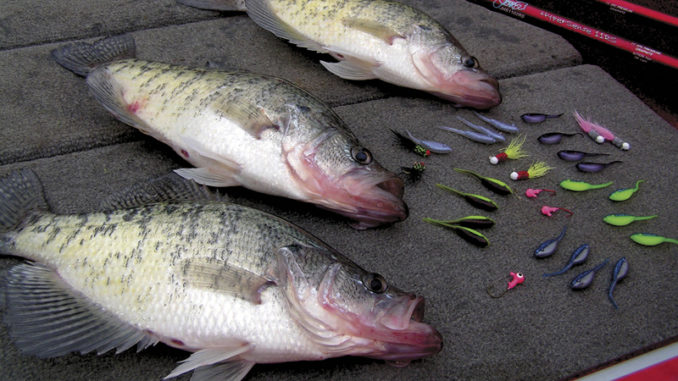
Interest in fishing for crappie has increased tremendously, and that’s nothing but good news for fishermen who are interested in targeting slabs.
Crappie are the new bass.
Think about it. What does that mean? During the past several decades, bass-fishing has been the premier freshwater fishing activity around Louisiana and, in fact, the whole country.
Big tournaments, famous fishermen, elaborate bass boats, rods, baits and all kinds of equipment. Well, don’t look now, Mr. Green Trout, but crappie are swimming right up behind you and beginning to take center stage.
Crappie fishing 2020 is not your daddy’s crappie fishing. Whether you call them crappie, white perch or sac-a-lait, fishing for them is following the same patterns that bass fishing did way back when.
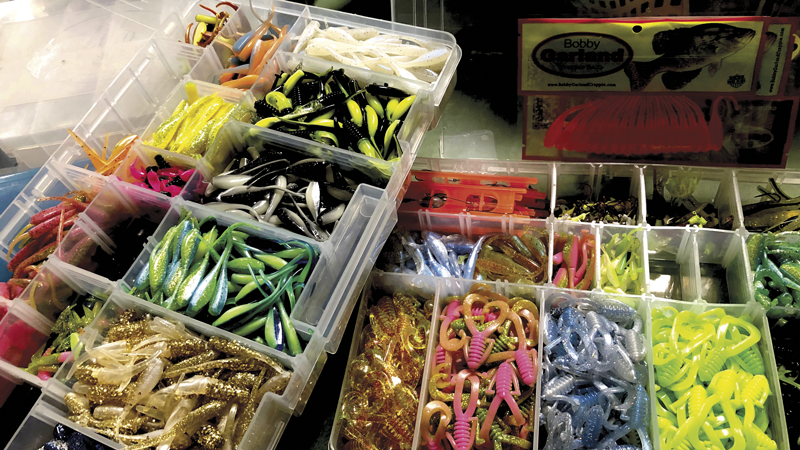
Ever hear of Crappie University? It’s an extensive class taught by crappie pros around the country, and in recent years, they’ve been held in Bossier City, Lafayette and Lake Charles. More cities may be added to the list. The event in Bossier drew more than 200 fishermen who paid $89 each to attend.
There’s even a national online group of thousands of crappie fishermen called crappie.com who chat and share fishing reports and tips. A Louisiana group has its own forum and holds annual gatherings.
Tournaments
Crappie tournaments? Here they come. The American Crappie Trail and Crappie Masters have both laid claim to Louisiana waters as prime targets for pro crappie events. The Ouachita River and Lake D’Arbonne, two prime, slab-producing bodies of water that draw anglers from around the country, have already been sites of big tournaments. The ACT held its national championship this past March on Lake D’Arbonne, offering $100,000 in cash and prizes, including two new boats.
In 2020, Crappie Masters will hold its national championship on the Ouachita River out of Monroe, with the largest payout to date for a crappie event, $125,000 in cash and prizes. Plans have already been finalized to bring that event back to Lake D’Arbonne in Farmersville in 2021.
In addition, the number of recreational crappie fishermen is growing every day. There isn’t enough space to cover the changes in equipment. Crappie anglers now carry more rods and reels; more sizes, shapes and colors of baits — even $100 insulated mini-livewell minnow buckets and other equipment than most bass anglers did 10 years ago.
And electronics? The development of LiveScope and other similar technologies lets crappie fishermen actual “see” fish underwater, and a keen eye can even distinguish big crappie from little crappie. When an angler drops his or her bait down to the fish, they can even see the fish swim up and take it. If that’s not enough, today’s top-line trolling motors allow anglers to simply push an “anchor” button and, using GPS technology, the trolling motor will hold you in that exact spot. That kind of gear does come with a price. An electronics package can run an angler $6,000 or more installed, more than most crappie fishermen used to spend on their whole boat.
New techniques
Techniques have changed since anglers fished with a cane pole, a big bobber with a shiner on a single hook. Today, anglers still fish with single poles, but they also spider-rig, long-line, troll, fish double-minnow rigs and cast and wind small spinners, especially in the spring when fish are shallow for the spawn.
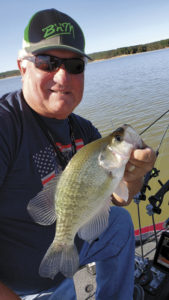
The icing on the cake is the crappie themselves. They are more plentiful, easier to locate and stand up to fishing pressure much better than bass. While bass anglers get nervous and mad when another angler gets within 50 yards of their boats, crappie fishermen often fish close enough to each other to carry on a conversation without causing too many problems. The bottom line: fishing is fun, but catching is even better.
What’s all this mean? For competitive anglers, it means a chance to enjoy the sport and pick up a little extra fish-bait money. Traveling pros who can win, place or show regularly will pick up sponsors can almost make a living at it.
For the average crappie fishermen, it’s good news, too. The baits, equipment and tackle, plus all the new techniques, can help anybody catch more fish, more consistently and in more places. And easy to understand instruction on how and where to catch crappie is readily available, not handed down in secret like some old family recipe for grandma’s fried chicken.
Ronnie Capps shows off his first prize “check” for a tournament win earlier this year. Not a bad payday for two days of fishing.
This could be the year to test the competitive crappie waters
If you ever wanted to try your hand at professional crappie fishing in Louisiana, there might not be any better time than 2020.
Whether you call them sac-a-lait, white perch or crappie, there are some first-time opportunities for anglers to chase these fish for cash in Louisiana this year, everything from club tournaments just for north and south Louisiana, regular qualifying professional events and even a world championship headed our way with the world’s largest crappie payout to date. Two of the country’s top three circuits will have events here.
Opportunities
Crappie Masters will be holding regular events Feb. 28-29 on D’Arbonne and May 1-2 on the Ouachita River. But the biggest news is its national championship Sept. 23-26 on the Ouachita River out of Monroe. The CM National Championship will be the richest crappie tournament ever, with a $125,000 payout, including $110,000 in cash.
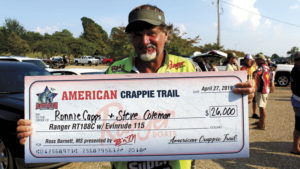
The American Crappie Trail has a regular-season qualifier Aug. 28-29 on the Ouachita River. The most-innovative event in Louisiana may well be the new ACT Pro-Am. Three pro-ams will be held in 2020, according to Matt Morgan, ACT’s present: Feb. 29-March 1 on the Alabama River, April 18-19 on Grenada Lake and Sept. 12-13 on Lake D’Arbonne at Farmerville.
“The Pro-Am format is the first of its kind where a pro fisherman can control the boat and compete for top dollars, and a guy who may have never even crappie fished can hop in the boat with him and go fish for two days and learn more than he ever dreamed, also while fishing for cash and prizes,” Morgan said. “Stars will be made. Heroes will be born in these events. Not a single sport in this world can grow without superstars, and the Pro-Am will help do that for the ones who are most successful. We can’t wait.”
What’s different about 2020
Crappie clubs and tournaments have existed in Louisiana, but never two organized circuits with an affordable $100 entry fee as 2020 will offer. The Crappie Masters South Louisiana Trail will consist of tournaments on Lake Verret, Feb. 15; Lake Des Allemands, March 21; the Atchafalaya Basin, April 18; Lake Verret, May 23; Bayou Black, June 27; Lake Des Allemands, July 18; and the Club Championship on Lake Verrett and the Basin, Aug. 15-16.
The North Louisiana Trail will consist of the Claiborne Show Down, Lake Claiborne State Park, Jan, 18; Battle on the Bone, Lake D‘Arbonne State Park, Feb, 15; Caney Crack Down, Jimmie Davis State Park, March 21; Ouachita River Rumble, Forsythe Park, April 25; Red River Rumble, Red River, May 9; Grand Bayou Smackdown, June 20; D’Arbonne Rematch, July 25; and Ouachita River Part Deaux, Aug. 8.
“There are only so many traveling teams out there that can take the time and money to travel state to state, but my thinking is the club tournaments will build sort of a farm system for anglers to test the waters and build up their confidence to go further in the sport,” said Mike Valentine, president of Crappie Masters. “We’ve got to start growing this sport and reaching more people and this is a great way to do it.”
“Fighter jet” technology in today’s crappie boat
Dan Dannenmueller, Sr., sat down in one of the padded chairs in the front of his new Ranger Z521L crappie rig — they used to call them bass boats — and began surveying all the new technology within his reach.
He began to explain how the Garmin Live Scope and echoMAP P93svs depth and fish-locator technology worked. There was his new GPS-guided Garmin trolling motor, adjustable Driftmaster rod holders, Valor down tube and too much other equipment to mention.
It begged a question for Dannenmueller, a retired U.S. Air Force veteran from Wetumpka, Ala.
“Seriously, did you have this much high-tech equipment when you were in the Air Force”, he was asked.
“No,” he chucked. “I don’t guess I did. Especially in the earlier years.”
Dannenmueller’s rig is top of the line and, before even adding rods, reels, baits, life vests, etc, it would retail for around $105,000.
Welcome to the new world of crappie fishing.
You don’t have to have a rig like that to catch crappie, but as Dannenmueller said, “Everything on that boat gives me an advantage in certain situations, from the gear up front to the Yamaha 250 VMax outboard and PowerPole Drift Paddles on the back. When you fish as much as we do, especially competitively, I couldn’t do without it.”
Capps and Coleman
In the world of competitive crappie fishing, no names are better known than Ronnie Capps and Steve Coleman.
Capps said all the technology is a huge benefit for fishermen who need to make the best use of limited time on the water. Both have retired, Capps as a wildlife officer with the Tennessee Wildlife Resources Agency and Coleman as an employee at the Lake County Regional Prison. The Tiptonville, Tenn., duo has been fishing together since they were teenagers.
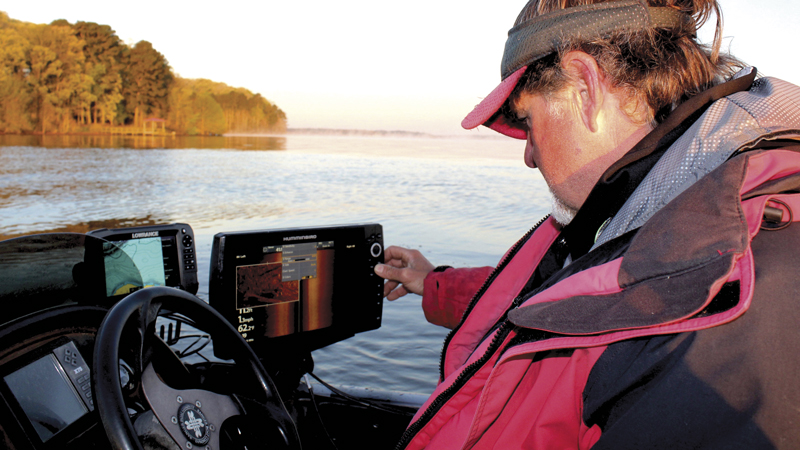
“You don’t have to spend a day or two fishing different depths and areas of the lake to find where the fish are,” he said. “You can find them on the electronics, mark them and spend more time catching than just fishing. Crappie move a lot as well, and it often isn’t very far. You can use technology to find them again, stay on them, and again catch fish.”
A history of success
Capps and Coleman have won the B’n’M Angler Team of the year two years in a row and have won more than $1 million in competitive crappie fishing. They also designed one of the best crappie-catching rigs: the double-minnow rig. Capps & Coleman minnow rigs have pre-rigged hooks, line, weight and swivels that you can just tie to your line and immediately start fishing two live shiners. Part of the B’n’M line, they come in four sizes from ¼-ounce for fishing from 2 to 7 feet deep to ½-ounce for fishing from 7 to 12 feet deep up to ¾-ounce for fishing as deep as a crappie wants to go.
The weights are important because they hold the bait down in the strike zone no matter how fast you want to troll. The directions on the back of the pack show you everything you need to know. Here’s a special tip — you can even take the ¼-ounce rig and cast it, retrieving it slowly under a slip cork when fish are in 4 to 8 feet of water. You can also build your own double-minnow rig if you have the patience.
A different approach
Even with all the giant rigs today, some successful anglers still go “old school” to some extent. Take “small boat mafia” fishermen like Patrick Matthews of Junction City and Tim Elrod of West Monroe. They consistently do well in tournaments, including pro events. Matthews has a big boat but often prefers to fish out of a 15-foot aluminum boat with stick steering and a 30 HP Mercury outboard on the back, top speed about 11 mph.
“To be honest, I grew up poor. Really poor,” he said. “We didn’t have the best of everything, and when everybody else came along with the new things, the big things, we didn’t get it, and it was kind of intimidating. I learned quickly that isn’t important. Now, I’ve got a big boat with all the gadgets, but I’ve got this little stick-steering boat, too.
“When Tim and I started fishing together, we started thinking maybe we couldn’t compete with all these guys in the big rigs, but then we realized we can. We said they are just human beings just like both of us. We just need to do what we do best. It’s no knock on them. That’s what they are doing. So we go in the boat that we are comfortable in — the stick-steering aluminum with a small motor and a two seater without the bells and whistles. When we fish shallow water, we don’t even depend on the electronics.”
The types and sizes of boats that today’s crappie fishermen use are as varied as the baits and poles they use. But make no mistake, the guys that fish smaller boats also use the new electronic technology most of the time, as well as the best crappie poles, lures and insulated minnow keepers as well.


